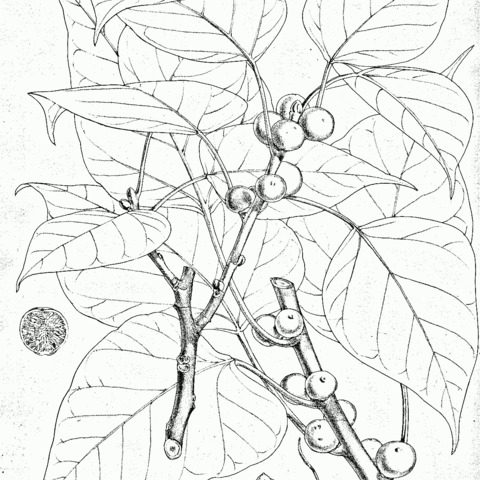Trees, ca. 15 m tall, usually epiphytic. Bark gray, wrinkled when dry. Stipules caducous, ovate-lanceolate, 1.5-2.5 cm, scar conspicuous. Petiole 6-8 cm, glabrous; leaf blade cordate to ovate-cordate, 6-13 × 6-11 cm, ± leathery, glabrous, base ± cordate to broadly cuneate, apex acuminate; basal lateral veins 4, outer 2 basal veins short and thin, secondary veins 5 or 6 on each side of midvein. Figs axillary on leafy branchlets, paired or in small clusters on leafless older branchlets, with dark spots when young, dark purple when mature, globose, 1-1.5 cm in diam., sessile; involucral bracts orbicular, small; apical bracts ± navel-like. Male, gall, and female flowers within same fig. Male flowers: few, scattered among other flowers; calyx lobes 3, spatulate; stamen 1. Gall and asexual flowers: calyx lobes 3, lanceolate. Female flowers: ovary white, ovoid, smooth; style persistent, long; stigma clavate. Achenes thin, tuberculate and with adherent liquid; style long; stigma clavate.
A fig. It is a tree. It grows about 15 m tall. Usually it lives growing on and attached to other trees. The bark is grey and wrinkled when dry. The leafy growth at the base of the leaf is oval and 1.2-2.5 cm long. It leaves a scar which is easy to see. The leaf stalk is 6-8 cm long. The leaf blade is heart shaped or oval and 6-13 cm long by 6-11 cm wide. It is somewhat leathery. The base is broadly wedge shaped and it tapers to the tip. There are 4 veins near the base then 5-6 secondary veins on each side of the main vein. Normally there are a pair of figs in the axils of leaves. Sometimes they are in groups on older leafless branches. They have dark spots when young. They are dark purple when mature. They are round and without stalks. They are 1-1.5 cm across. There are only a few male flowers scattered amongst the other flowers.

